http://earthsky.org/space/this-date-in-science-edwin-hubble-and-the-expanding-universe#.Uozg2rBME0M
Happy Birthday Hubble!
Posted from WordPress for Android via my Samsung smartphone. Please excuse any misspellings. Ciao, Jon
Sunsets, Stars, West, Wind
http://earthsky.org/space/this-date-in-science-edwin-hubble-and-the-expanding-universe#.Uozg2rBME0M
Happy Birthday Hubble!
Posted from WordPress for Android via my Samsung smartphone. Please excuse any misspellings. Ciao, Jon
NASA’s Voyager 1 Explores Final Frontier of Our ‘Solar Bubble’ – NASA Jet Propulsion Laboratory
http://www.jpl.nasa.gov/news/news.php?release=2013-209
To go where no one has gone before.
 Friday turned into a very long day indeed. I took the afternoon off to accompany my husband to a doctor’s visit to discuss the next steps in managing his condition. That appointment went better than I thought it would and I’m grateful for the information and the prospects. We will persevere.
Friday turned into a very long day indeed. I took the afternoon off to accompany my husband to a doctor’s visit to discuss the next steps in managing his condition. That appointment went better than I thought it would and I’m grateful for the information and the prospects. We will persevere.
We got back home with just thirty minutes to spare before venturing out again, this time a couple of miles west of us (on the other side of Lansing) to attend the grand opening of a new farmer’s market. We’ve known the family that owns the farm for years, and we love to buy locally grown produce. We didn’t stay long as I needed to research and prep for the star party at Powell.
I received the ‘all clear’ or ‘go ahead’ e-mail from the ASKC star party coordinator earlier in the afternoon. I called my dad to see if he wanted to join me. He had a conflict so I asked my husband. He preferred to stay home. So I was on my own.
First thing I needed to do was dust off the 8-inch Dob. Then I attempted to collimate it. Then I dialed in the finder scope. I didn’t remember until later that I’d purchased, back in October, a new finder scope, so I missed the opportunity to try it out. The weather forecast for the rest of the weekend doesn’t look good for more testing opportunities.
Next, I found my Astro Quest Observing checklist and started planning my overly ambitious observing list for Friday night’s star party. I’ve been working on this observing award for nearly two years now. I really need to step it up and get it done! I got a bit distracted when I realized I hadn’t recorded some of the observations I made last fall and winter. Eventually, I returned to those items I’ve yet to observe that would be the best candidates for an early June dark-of-the-moon night sky. I used my Pocket Sky Atlas and the Android App SkySafari Plus on my Samsung Galaxy Note II to select twenty items. I added these targets to a list in the app:
I partially disassembled the Dob for transport, placing the tube in its carrying case. I had some concern that the base would not fit in the trunk of my car, but it did, barely. I discovered my portable emergency red light battery needed charging so I plugged it in a couple of hours before I needed to leave. I found a lawn chair and a table I could take. I forgot two items that in hindsight I should have brought with me: 1) the monopod for my binoculars (to reduce shaking while observing) and 2) Deep Woods Off or some other Deet laden bug spray. I got everything into the car, except the charging battery, and watched the clock tick down to 7:30 p.m.
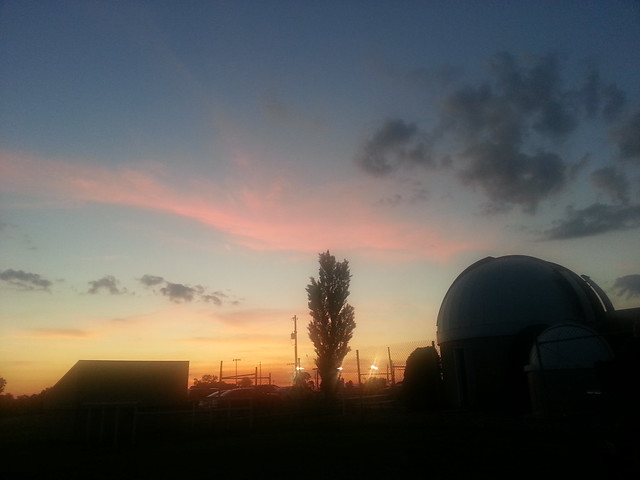 The drive to Powell Observatory near Louisburg took an hour, but I enjoyed listening to my audiobook and dodging Johnson County drivers. I arrived to a gorgeous sunset (see photos above and at right). I also noticed a baseball game in progress to the northwest of the observing field (you can see the field lights already on in the photo above). These lights became an annoyance for the next two hours.
The drive to Powell Observatory near Louisburg took an hour, but I enjoyed listening to my audiobook and dodging Johnson County drivers. I arrived to a gorgeous sunset (see photos above and at right). I also noticed a baseball game in progress to the northwest of the observing field (you can see the field lights already on in the photo above). These lights became an annoyance for the next two hours.
I opted to park in the parking light north of the observatory and across the street. Several ASKC members were already setting up their telescopes east of the dome. The parking lot to the west of the dome was filled with what I assumed to be a private party that had reserved the dome facilities for the evening. It took me three trips to get the telescope and accessories from the car to the observing field. While I made these trips, the star party coordinator informed me I could have driven my car around the dome onto the observing field to make my life easier. But I excel at doing things the hard way. Maybe next month I’ll be lazier.
I put the scope back together and checked the alignment of the finder scope. Then I settled into my lawn chair to wait for darker skies. Eventually, around 9:30 p.m., I got my binoculars out and waited for Venus, Mercury and Saturn to pop out in the twilight. I observed all three of these planets with binoculars and with the 8-inch Dob. I could clearly see that Mercury was half full (or is that more properly referred to as quarter illuminated?).
During this time (after sunset but before the ball field lights were extinguished), we saw the ISS pass over in the northern part of the sky.
I used my binoculars to locate M13 in Hercules and I used the scope to find M4 in Scorpius. I roamed around the sky with my binoculars, relaxing in my lawn chair, getting increasingly annoyed by the brightness of the ball field lights. I also started to notice an accumulation of dew on just about everything. When I would pick up my binoculars and look through them, often I would see bright halos instead of pin pricks of starlight. Any printouts I had sitting on my table quickly became sodden and unusable.
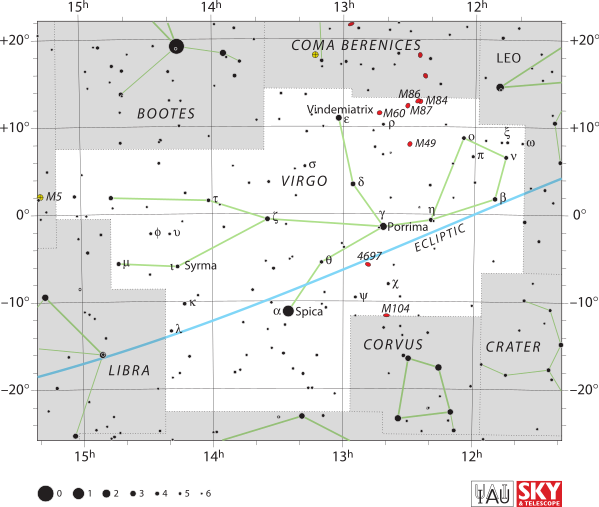 The ballgame finally wrapped up a few minutes before 10:30 p.m. We all cheered when the lights finally died and we could let our eyes adjust to the dark. Within fifteen minutes, I had found the Sombrero Galaxy (aka M 104) in the constellation Virgo. This was my first chance to really field test using SkySafari Plus on my smartphone, using the night vision setting (red display) and the ability to zoom-in to match the field-of-view I saw through my scope’s eyepiece. Made star hopping easier. No more juggling my reading glasses, a red light flashlight and my Pocket Star Atlas. To find the galaxy, I actually came up from the constellation Corvus (see chart above).
The ballgame finally wrapped up a few minutes before 10:30 p.m. We all cheered when the lights finally died and we could let our eyes adjust to the dark. Within fifteen minutes, I had found the Sombrero Galaxy (aka M 104) in the constellation Virgo. This was my first chance to really field test using SkySafari Plus on my smartphone, using the night vision setting (red display) and the ability to zoom-in to match the field-of-view I saw through my scope’s eyepiece. Made star hopping easier. No more juggling my reading glasses, a red light flashlight and my Pocket Star Atlas. To find the galaxy, I actually came up from the constellation Corvus (see chart above).
I had to abandon searching for dim nebula and the harder to find variable stars on my observing list because of the persistent haze that hung over the sky. While I was grateful for the lack of wind, this also resulted in no movement of the thin clouds. I had to focus on brighter objects. I did observe, in my binoculars, the stars Thuban, Adhafera and Sarin, but I did not attempt R CrB or 48 Librae, which require better seeing conditions to locate via star hopping.
 During the eleven o’clock hour, I set my sights on locating M5, a globular cluster, found in the constellation Serpens. I’ve tried a couple of times in the past to locate this cluster, but there are no bright stars near it to guide you to it. Since I’m trying to perfect my star hopping abilities (and didn’t bring my “goto” telescope with me), I again used the SkySafari Plus, zoomed in to with in a couple of degrees of the cluster, to find a suitable path among the faint stars. At first I attempted from the east (my left) using some stars in the Serpens constellation, but I kept getting lost (or nowhere), so I changed tactics and thought I’d try coming ‘up’ from Libra. No luck there either.
During the eleven o’clock hour, I set my sights on locating M5, a globular cluster, found in the constellation Serpens. I’ve tried a couple of times in the past to locate this cluster, but there are no bright stars near it to guide you to it. Since I’m trying to perfect my star hopping abilities (and didn’t bring my “goto” telescope with me), I again used the SkySafari Plus, zoomed in to with in a couple of degrees of the cluster, to find a suitable path among the faint stars. At first I attempted from the east (my left) using some stars in the Serpens constellation, but I kept getting lost (or nowhere), so I changed tactics and thought I’d try coming ‘up’ from Libra. No luck there either.

Finally, I moved to the west, to the right leg of the constellation Virgo, and used stars tau and 109 to draw a line due east (to the left) directly to M5. Huzzah! I found it at 11:30 p.m. I observed the cluster, as best I could with the less than stellar seeing conditions, and sat savoring the triumph of finally locating this illusive globular cluster.
 Several other star party attendees had started packing up their equipment, probably because of the dew and the haze. I wanted to stick it out, at least until midnight, so I quickly scanned through my observing list and decided to investigate the 13th constellation in the Zodiac (or rather, one of the thirteen constellations that cross the ecliptic) and find an open cluster, IC 4665. It should have been visible with binoculars, but I had little hope of that. Ophiuchus, also known as the Serpent Bearer, is a large constellation between Sagittarius and Scorpius. I used the nu and tau stars to guide me to the open cluster. I could see it well (although it barely fit in the field of view) via the scope, but could not discern it through my binoculars, which kept fogging over and became more and more useless as the night progressed.
Several other star party attendees had started packing up their equipment, probably because of the dew and the haze. I wanted to stick it out, at least until midnight, so I quickly scanned through my observing list and decided to investigate the 13th constellation in the Zodiac (or rather, one of the thirteen constellations that cross the ecliptic) and find an open cluster, IC 4665. It should have been visible with binoculars, but I had little hope of that. Ophiuchus, also known as the Serpent Bearer, is a large constellation between Sagittarius and Scorpius. I used the nu and tau stars to guide me to the open cluster. I could see it well (although it barely fit in the field of view) via the scope, but could not discern it through my binoculars, which kept fogging over and became more and more useless as the night progressed.
I still had a few minutes to go before tomorrow arrived, so I turned the scope northward, to Ursa Major, hoping to find the Owl Nebula. Unfortunately, looking north from Powell Observatory means looking back through the entirety of Kansas City and all its glorious star-obscuring light pollution. I made a half-hearted attempt to locate the nebula and decided enough was enough.
I switched on my portable battery and it’s ’emergency’ red light (in non-flashing mode) so I could see my observing site well enough to start packing up the equipment. Everything was soaked in dew. Thank goodness my Pocket Sky Atlas is designed for moisture-laden environments. The paper it’s printed on isn’t traditional paper. I suspect a high content of plastic.
Three trips later, I had everything back in the car. I pulled out of the parking lot at six minutes past midnight and pulled into my driveway an hour later. I went straight to bed.
Final thoughts? I was able to check off three of the twenty items from my observing target list. Not nearly as many as I had hoped to find, but given the conditions, I’m satisfied with the results. I’ll give it another go next month and as I can from my backyard, weather permitting.
 Despite a busy weekend of van maintenance (oil change/tire rotation), hair maintenance (shampoo, cut & style), yard maintenance (leaves, leaves and more leaves and now pine needles), home improvement projects (refinishing lower kitchen cabinets) and exercise (very long walk with Apollo), I squeezed in an hour of star gazing after a night out with Terry and friends at Jack Stack on the Plaza. I’ve been wanting to get the scope out for a couple of weeks now, but the evening skies have not cooperated, remaining hazy at best or completely cloud covered at their worst. Upon parking the car in the driveway Saturday night, I looked up and decided the skies looked good enough to attempt some star gazing. I didn’t even take my purse into the house. I drug the telescope out of the garage and began hunting down more targets on my Astro Quest observing award checklist.
Despite a busy weekend of van maintenance (oil change/tire rotation), hair maintenance (shampoo, cut & style), yard maintenance (leaves, leaves and more leaves and now pine needles), home improvement projects (refinishing lower kitchen cabinets) and exercise (very long walk with Apollo), I squeezed in an hour of star gazing after a night out with Terry and friends at Jack Stack on the Plaza. I’ve been wanting to get the scope out for a couple of weeks now, but the evening skies have not cooperated, remaining hazy at best or completely cloud covered at their worst. Upon parking the car in the driveway Saturday night, I looked up and decided the skies looked good enough to attempt some star gazing. I didn’t even take my purse into the house. I drug the telescope out of the garage and began hunting down more targets on my Astro Quest observing award checklist.
 I did make one trip inside to retrieve my binoculars, pocket star atlas, clipboard and checklist. I used Jupiter to re-align the finderscope and spent several minutes enjoying an interesting moon alignment (see image above).
I did make one trip inside to retrieve my binoculars, pocket star atlas, clipboard and checklist. I used Jupiter to re-align the finderscope and spent several minutes enjoying an interesting moon alignment (see image above).
 Using binoculars, I easily found the Andromeda galaxy and the Double Cluster (between Perseus and Cassiopeia). I checked off two stars from my list, Algol in Perseus and Gamma Cassiopeiae. Since the constellation Pegasus was nearly directly overhead, I went hunting for the Triangulum galaxy, also known as M33. I could barely see the three stars in the constellation Triangulum, but no matter how hard I searched (with binoculars, not naked eye), I could not find this galaxy. I should have been able to trace a line from M31 through two stars in the constellation Andremeda (Mu and Beta Andromedae) to find M33, but I was defeated once again by urban (and prison) light pollution. I had hoped to stumble upon it with binoculars, especially since M31 was so easily visible and found (almost naked eye Saturday night, but not quite).
Using binoculars, I easily found the Andromeda galaxy and the Double Cluster (between Perseus and Cassiopeia). I checked off two stars from my list, Algol in Perseus and Gamma Cassiopeiae. Since the constellation Pegasus was nearly directly overhead, I went hunting for the Triangulum galaxy, also known as M33. I could barely see the three stars in the constellation Triangulum, but no matter how hard I searched (with binoculars, not naked eye), I could not find this galaxy. I should have been able to trace a line from M31 through two stars in the constellation Andremeda (Mu and Beta Andromedae) to find M33, but I was defeated once again by urban (and prison) light pollution. I had hoped to stumble upon it with binoculars, especially since M31 was so easily visible and found (almost naked eye Saturday night, but not quite).
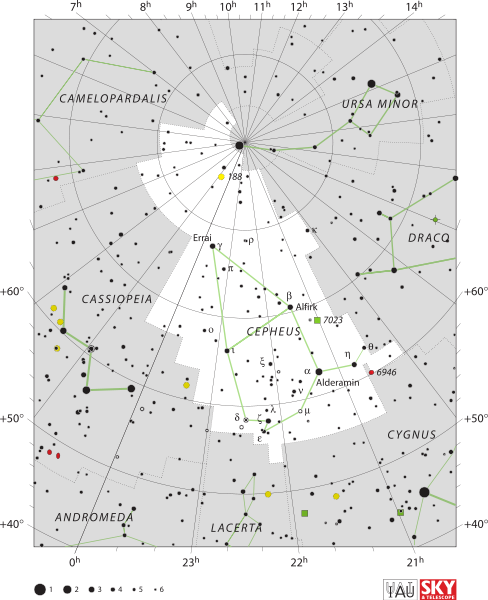
I became more chilled as the evening wore on, neglecting to put on my sweater and just ignoring the 40 degree temperatures. The lack of wind helped shore up my illusion of warmth. I thought I’d try one last object before packing the scope up and returning it to the garage. I went hunting for the Garnet star in the constellation Cepheus. With my naked eyes, I could barely make out some of the stars that form the ‘house’ asterism. I knew the general area to look for Mu Cephei so I aimed my binoculars between the alpha and delta stars. Whoa! Way, way too many stars visible, thanks to the backdrop of our own Milky Way galaxy. Staring again with just my eyes, I squinted against the light pollution, but could still only see some of the anchor stars of Cepheus and no Milky Way stars.
I gave up, because I knew I would need to study several star atlases closely and device a star hop from Alpha Cephei to Mu Cephei, a trail I would need to memorize, so I wouldn’t have to take my reading glasses on and off while attempting to observe.

Another star trail I need to work on is finding M15 in the constellation Pegasus. I really shouldn’t have had any trouble finding M15, since you can draw a nearly strait line from Theta Pegasi through Epsilon Pegasi to point to that globular cluster. Either my skies were not dark enough, or I kept misidentifying Enif (Epsilon Pegasi) in my binoculars.
I received the alert from my calendar ten minutes before five o’clock Wednesday morning. I wanted to make sure I woke up early enough to have dark skies (well, as dark as they get in my neck of the woods) to observe the Beehive Cluster aligned with Venus and the waning Moon. I planned ahead and had all my equipment ready to go before I went to bed Tuesday night. I subscribe to several astronomy related RSS feeds and always review Astronomy.com‘s “The Sky This Week” as soon as it’s updated to make sure I mark my calendar for interesting observation events. The following is an excerpt from this week’s article:
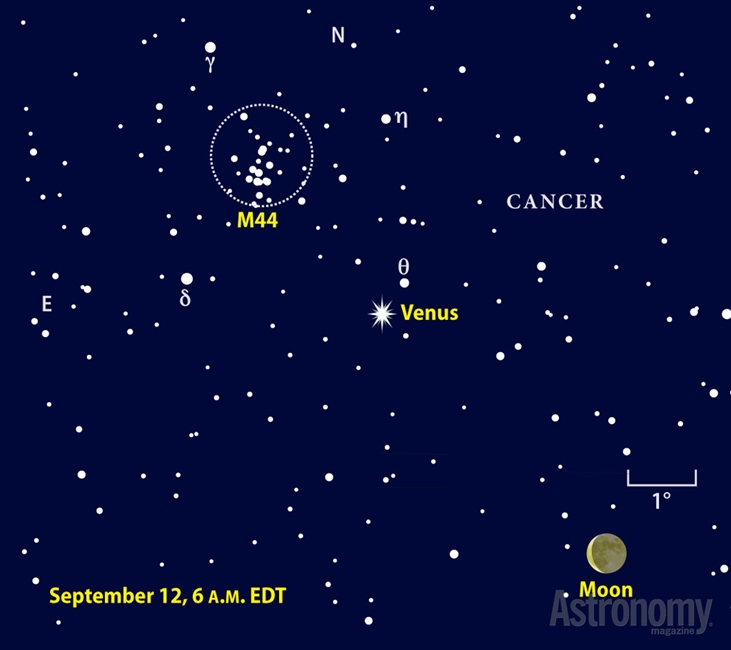
Wednesday, September 12: If you enjoy seeing spectacular celestial alignments, this is the morning for you. A waning crescent Moon stands 4° southwest of brilliant Venus before dawn while the planet resides 3° southwest of the Beehive star cluster (M44). Although the scene will be lovely with naked eyes under a dark sky, binoculars will deliver the best views. To see the Beehive clearly, you’ll need to observe before twilight begins around 5 a.m. local daylight time. The Moon and Venus remain stunning until about 15 minutes before the Sun rises (from Astronomy.com‘s “Sky This Week” article).
A few stray small puffy clouds drifted around the night sky. A slight breeze blew in from the south or southwest, but my house sheltered the driveway where I setup the tripod and camera. I could not see any of the stars in the constellation Cancer with my naked eye. I live less than ten miles due west, as a bird flies, from the Kansas City International Airport, and the rest of Kansas City sprawls continuously south along the eastern horizon down to the southeast quadrant. Seeing anything faint below 20 degrees above the horizon is not easily accomplished.
With my binoculars, I could see the stars that make up Cancer, and I could clearly see the Beehive Cluster (M44). I affixed my telephoto lens to my camera, but looking through the tiny viewfinder I could only see Venus. So I guessed as best I could with placement relative to Venus and took a few photos. I tried to capture a few other interesting objects much higher in the sky, like Jupiter, Orion’s sword, and the Pleiades again.
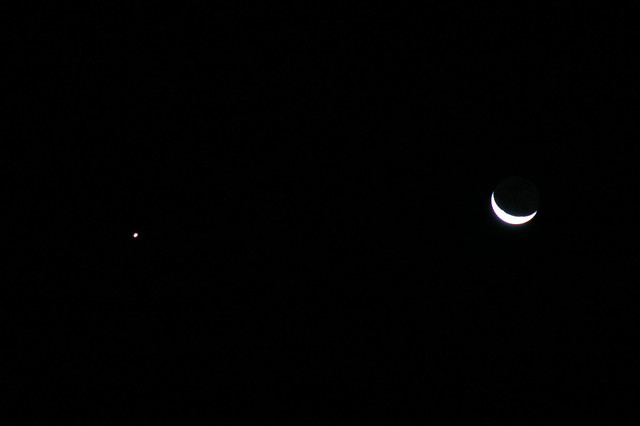
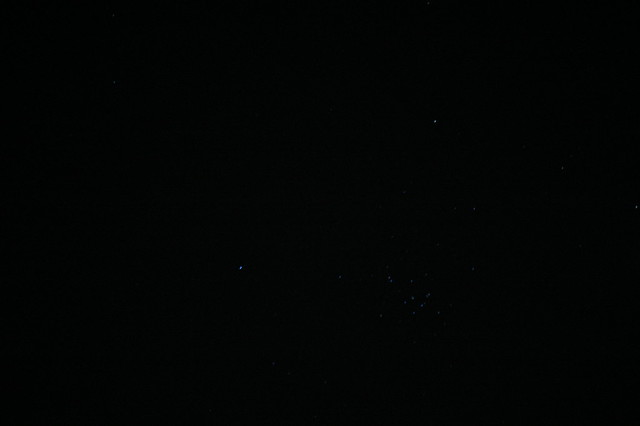

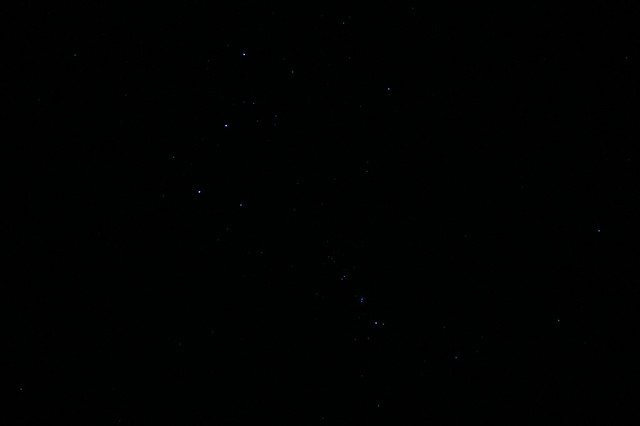
Click here to see the entire album of photos from Wednesday morning.
Thursday dawned completely overcast, with rain scheduled for the entire day. We need it so I’m not complaining.
Friday night I’ll attend the club’s local star party and have already organized my observing list so I can make great strides towards my Astro Quest observing award. Friday morning, if I can manage it after observing late into the night, I hope to capture the last glimpse of the old moon before it turns new around nine o’clock Saturday evening.
Redundant title, but I felt the need to bewitch you by using the word ‘betwixt.’ When I stepped outside this morning, about ninety minutes before sunrise, I looked up and couldn’t believe the incredibly bright stars and planets I could see against a dark sky. Very unusual sight from my front steps. I even called my husband out to look at the gorgeous perfect visibility of the entire constellation Orion. We could even see all seven stars of the Pleaides, directly overhead. I couldn’t resist the siren call of my camera, so I went back inside, grabbed the tripod and the camera and took a half dozen photos.

Yesterday morning, the moon was a bit brighter and closer to Jupiter.
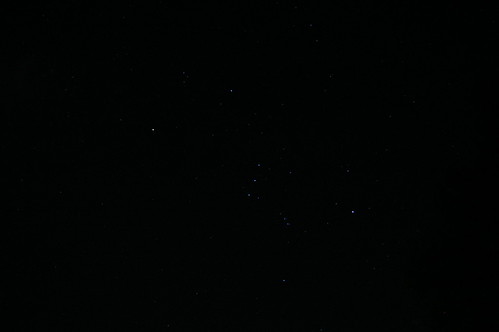

Click on any of the above images to see larger versions of them.
I can’t wait to see what tomorrow morning has in store for me.
I couldn’t wait for midnight Friday night. The forecast for the weekend seemed unbelievable, especially after the scorching heat of the last month. Clear skies and mid to lower 80s for the high temperatures over the next several days. I came home from work to a grilled steak and baked potato dinner, prepared by Terry. Mmm-mmm good.
After dinner, Terry and I began reviewing the DVR play list and guide, deciding to delete many old recordings to free up some disc space. Our daughter called and chatted with us for about forty-five minutes. The conversation ended abruptly when her phone battery died.
For dessert, Terry blended a frozen raspberry lemonade. I read for a few minutes, while slowly sipping the drink (trying to avoid a brain freeze). I asked him to wake me up around midnight so I could scout the skies in search of the Andromeda galaxy and the planet Neptune. Apollo followed me upstairs to the bedroom to join me in my nap.
Terry woke me up just shortly after midnight. I rubbed the sleep out of my eyes and found my flip flops. I followed Terry back downstairs to the band room and walked out the patio door to the back yard. The skies were clear, if not what you’d call dark (why do my neighbors leave their porch lights on all night long?). I went back inside for one of my star charts and a pair of binoculars. I didn’t trust myself to lug the telescope outside in the dark, not being completely awake yet. A survey with the binoculars should be sufficient for my first attempt.
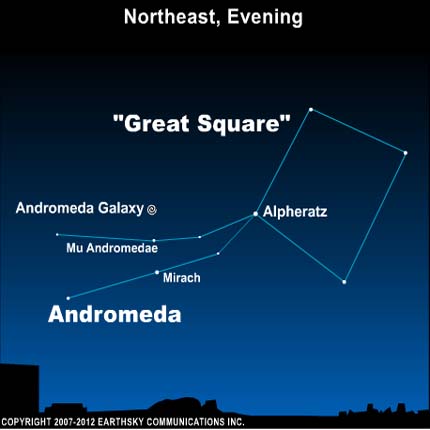 I walked out into my backyard, towards my one remaining pine tree and turned back around to face the east. What a difference a couple of hours makes! I could clearly see the Great Square of Pegasus hovering directly over my roof. In fact, my chimney seemed to be pointing a finger at the famous flying horse. I remembered what I’d read in the EarthSky post about finding the Andromeda galaxy and put what I’d learned to good use. With just a pair of mediocre binoculars, I easily found the smudge that is M31. Now I regretted not moving the XT8 outside before I took my nap.
I walked out into my backyard, towards my one remaining pine tree and turned back around to face the east. What a difference a couple of hours makes! I could clearly see the Great Square of Pegasus hovering directly over my roof. In fact, my chimney seemed to be pointing a finger at the famous flying horse. I remembered what I’d read in the EarthSky post about finding the Andromeda galaxy and put what I’d learned to good use. With just a pair of mediocre binoculars, I easily found the smudge that is M31. Now I regretted not moving the XT8 outside before I took my nap.
I turned ninety degrees to the right and began scanning the southern skies. I can’t see most of the southern horizon, which is blocked by my neighbors tall trees and houses (and all the exterior lighting attached to them). I lose a good twenty if not thirty degrees of sky in all but one direction, to the southwest I can see a bit of horizon, but only through the even worse light pollution generated by the parking lot of a doctor’s office and the streetlights along Main Street (also known as K-7/US-73).
 I needed to find the constellations Aquarius and Capricornus. The ecliptic passes through both of these constellations. Neptune swam the night skies somewhere between the two constellations on the invisible ecliptic course all the planets chart. The trouble in finding Neptune in this area of the sky comes from a lack of bright stars to anchor from for star hopping. I spent the next hour comparing the star atlas from my pocket guide to the stars I saw through the binoculars and eventually convinced myself I had found the southeastern tip of Capricornus. Just above those stars, I believe I found the two brightest stars in Aquarius, Sadalmelik and Sadalsuud, but those two stars were too high above the ecliptic and too far away in the field of view of the binoculars to find Neptune. I needed to do more research and next time use a telescope to help cut through the fog of light pollution.
I needed to find the constellations Aquarius and Capricornus. The ecliptic passes through both of these constellations. Neptune swam the night skies somewhere between the two constellations on the invisible ecliptic course all the planets chart. The trouble in finding Neptune in this area of the sky comes from a lack of bright stars to anchor from for star hopping. I spent the next hour comparing the star atlas from my pocket guide to the stars I saw through the binoculars and eventually convinced myself I had found the southeastern tip of Capricornus. Just above those stars, I believe I found the two brightest stars in Aquarius, Sadalmelik and Sadalsuud, but those two stars were too high above the ecliptic and too far away in the field of view of the binoculars to find Neptune. I needed to do more research and next time use a telescope to help cut through the fog of light pollution.
After an hour, I returned inside and went back to bed, resolved to research better star charts in the morning.
I went back to Astronomy.com and re-read the article on Neptune, but I just couldn’t relate their star chart (shown above) to what I’d observed last night through the binoculars. I would need more magnification and a more steady mount to zoom in and match up the stars shown above to the field of view of the XT8.
 I tried Sky and Telescope’s web page and found a better set of charts in a PDF format in their article about Uranus and Neptune visibility during 2012. I downloaded the document and will print it today to keep with the rest of my star charts.
I tried Sky and Telescope’s web page and found a better set of charts in a PDF format in their article about Uranus and Neptune visibility during 2012. I downloaded the document and will print it today to keep with the rest of my star charts.
Saturdays are always packed full of activities, so I’m hoping I’ll still have the energy tonight to make a second attempt at finding Neptune. My scouting trip showed me what I needed to overcome before I proceed with netting Neptune.
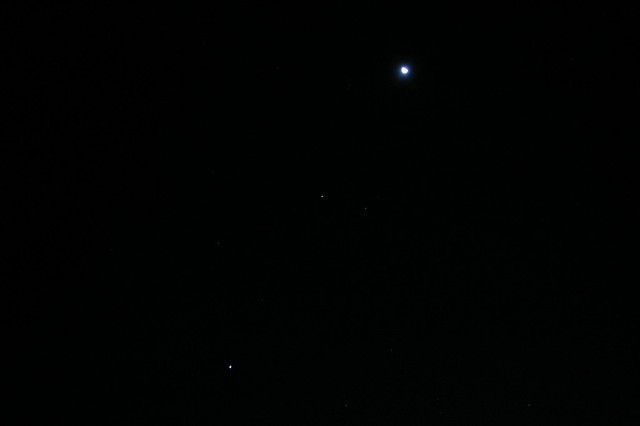
Very early Friday morning, I caught the waning moon approaching Jupiter and Aldebaran. You could draw a line from Venus to Moon and cross over or near Jupiter. The skies were clear and should stay clear throughout the day and into the night, with a forecasted high in the mid-80s, twenty degrees below what we’ve been experiencing for the past several weeks.
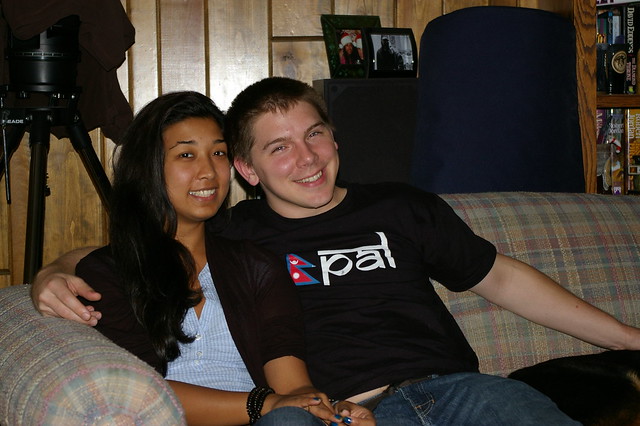 Friday at work was a whirlwind of meetings, including one held off site at another local law firm. I got home a bit early because one of my vanpool riders took the day off, but within fifteen minutes of getting home, my son and daughter-in-law arrived from their all-day road trip from North Texas. We visited with them for an hour and half, when they left to drive into Kansas City to spend the evening with several of their friends who still live in the area.
Friday at work was a whirlwind of meetings, including one held off site at another local law firm. I got home a bit early because one of my vanpool riders took the day off, but within fifteen minutes of getting home, my son and daughter-in-law arrived from their all-day road trip from North Texas. We visited with them for an hour and half, when they left to drive into Kansas City to spend the evening with several of their friends who still live in the area.
Terry cooked an excellent southern comfort food type dinner of chicken-fried minute steaks, organic green beans with turkey bacon, mashed potatoes and home-made white gravy. Too bad the kids didn’t hang around long enough to chow down with us. Terry and I let our food digest a bit, watching the Olympics until the skies darkened enough for some star gazing.
I grabbed the XT8 (affectionately known as ‘Dob’) and carefully carried it out to the lower backyard. This time I took a small table to put my charts on. I set my case of eyepieces on the ground. I brought out the Intelliscope handheld device to attempt an alignment. This device, unlike my ETX-90’s AutoStar, is only used to identify objects, not ‘go to’ them (since the XT8 does not have any motors). The Intelliscope can help you find objects with a warm/cold kind of seeking system. I still haven’t bought a stool to lean against, so my back aches a bit this morning. I did a two star alignment, finding and centering Arcturus first, then Vega.
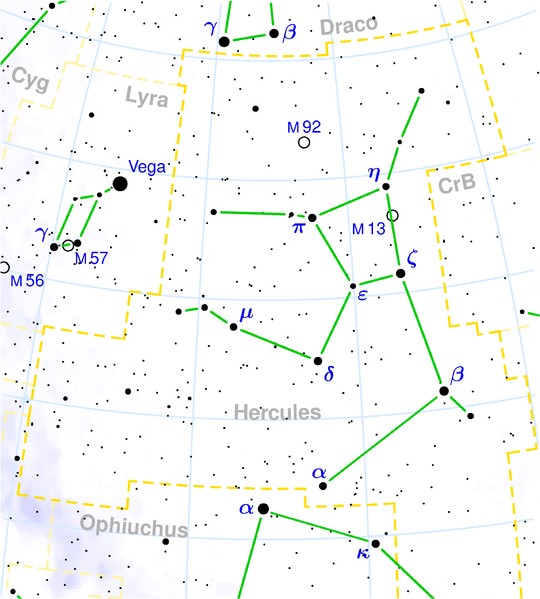 I wanted to revisit the Double Double in Lyra to both confirm that I could find it by star hopping and to attempt to see the double within the double. I asked the Intelliscope to ID what I had centered in the eyepiece and it claimed I’d found the Crab Nebula. Hmmm. That’s in the constellation Taurus, which isn’t visible until early morning hours in the east. I must have done something wrong in the alignment process. I powered off the Intelliscope device and made a note to myself to re-read the manual in the morning. Since I’d already found Vega, I spent several minutes comparing my star atlas to what I was seeing in the finderscope. I found Epsilon Lyrae and observed it with 26mm, 15mm, 9mm and a 2x barlow (using the 26mm and 15mm). Despite the apparent clearness of the skies, I did detect some haziness and thin stratus clouds overhead. That may have inhibited my ability to split the doubles within the doubles.
I wanted to revisit the Double Double in Lyra to both confirm that I could find it by star hopping and to attempt to see the double within the double. I asked the Intelliscope to ID what I had centered in the eyepiece and it claimed I’d found the Crab Nebula. Hmmm. That’s in the constellation Taurus, which isn’t visible until early morning hours in the east. I must have done something wrong in the alignment process. I powered off the Intelliscope device and made a note to myself to re-read the manual in the morning. Since I’d already found Vega, I spent several minutes comparing my star atlas to what I was seeing in the finderscope. I found Epsilon Lyrae and observed it with 26mm, 15mm, 9mm and a 2x barlow (using the 26mm and 15mm). Despite the apparent clearness of the skies, I did detect some haziness and thin stratus clouds overhead. That may have inhibited my ability to split the doubles within the doubles.
 I hopped over to Albireo in Cygnus, just to make sure I could find it again without referring to my star atlas. I used a trick I had read about from some artists who do astronomical sketching where you defocus the stars, especially doubles, to discern their different colors. I did this while observing Albireo and I could clearly see the red and blue for each star in the double. I stretched my back for a few minutes and stared off to the northeast, at Cassiopeia, which I could clearly see as a distinctive ‘W’ shape. I could not see the constellation Perseus, but I did see one or two meteors radiating from the space between Cassiopeia and where Perseus should have been visible (but wasn’t because of the haze and light pollution from the prison just north of my location).
I hopped over to Albireo in Cygnus, just to make sure I could find it again without referring to my star atlas. I used a trick I had read about from some artists who do astronomical sketching where you defocus the stars, especially doubles, to discern their different colors. I did this while observing Albireo and I could clearly see the red and blue for each star in the double. I stretched my back for a few minutes and stared off to the northeast, at Cassiopeia, which I could clearly see as a distinctive ‘W’ shape. I could not see the constellation Perseus, but I did see one or two meteors radiating from the space between Cassiopeia and where Perseus should have been visible (but wasn’t because of the haze and light pollution from the prison just north of my location).
I returned to the scope and began a star hop around Lyra in search of M57, also known as the Ring Nebula. This was a test, for me, not only of my ability to find this fuzzy smoke ring, but also of an 8-inch telescope’s ability to cut through the obstacles inherent at my closest observing site (my backyard). I surprised myself. I found the nebula, quicker than I thought I would, and I even saw it through the finderscope. It probably helped that Lyra was almost straight up above me and the telescope, meaning I had less atmosphere to peer through. Using averted vision, with the 9mm, I could clearly see the ring. I used the background stars to focus, because you can’t really focus well on a smudge that’s fuzzy and faint.
Since I found and saw a nebula with the XT8, I wanted to see if I could find a globular cluster next. And I just happened to know where one was. M13 in the ‘armpit’ of Hercules (see chart above) happened to be overhead, somewhere between Altair and Arcturus. I had some trouble locating the stars that make up Hercules with my naked eye. I took several minutes, stretching my back, to peer overhead, but towards the west, and Arcturus. Eventually, the star dots connected in my mind’s eye and I found the constellation. I oriented the XT8 to the general vicinity where I thought M13 would be. I think I saw it through the finderscope, although I can’t remember specifically. Using the 26mm eyepiece, I centered the globular cluster in my field of view and proceeded to observe this large dense cluster for several minutes with various magnifications.
 I stared off into the northeast again, still trying to find Perseus and also Pegasus. If I could see the Andromeda Galaxy (also known as M31), I would achieve a triple crown of astronomical observing from my backyard with the XT8 (1: nebula; 2: globular cluster; 3: galaxy). I spent nearly a half an hour, roaming around my backyard, changing my point of view and line of sight to the northeast and east. I found Cepheus, but no matter how hard I squinted or averted my eyes, I could not clearly identify the box that makes up the body of Pegasus. Frustrated, and with an aching back, I decided to call it a night at about half past eleven o’clock.
I stared off into the northeast again, still trying to find Perseus and also Pegasus. If I could see the Andromeda Galaxy (also known as M31), I would achieve a triple crown of astronomical observing from my backyard with the XT8 (1: nebula; 2: globular cluster; 3: galaxy). I spent nearly a half an hour, roaming around my backyard, changing my point of view and line of sight to the northeast and east. I found Cepheus, but no matter how hard I squinted or averted my eyes, I could not clearly identify the box that makes up the body of Pegasus. Frustrated, and with an aching back, I decided to call it a night at about half past eleven o’clock.
I returned the telescope to the band room and replaced all the dust caps. I hugged my hubby, for he had brought me a refreshing freshly made strawberry lemonade to enjoy while bending over the telescope for hours. Off to bed and sleep, at least until the dogs started barking when Derek and Royna returned home (sometime after midnight and before five – not exactly sure as I tried to sleep through the commotion).
My alarm only fires off on weekdays, but most days I wake up fifteen minutes early. Not Saturday morning though. When I cleared the sleep from my eyes and checked the clock on my cell phone, it read 5:45 a.m. and I could already tell the eastern horizon was brightening. I grabbed the tripod and camera and went out to the driveway to take a photo of the Moon approaching Jupiter.
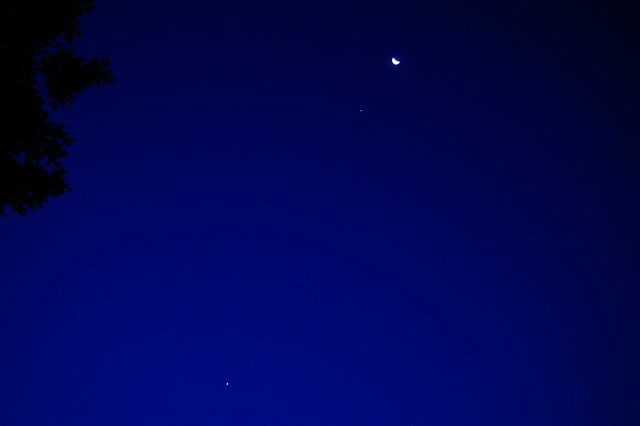
If I happened to live in the Pacific, today I would be able to observe the moon occulting Jupiter. But I won’t be too disappointed, since I can observe the moon occulting Venus next Monday afternoon, between 3:00 and 4:00 p.m. I plan to take a pair of binoculars and my camera equipment with me to work. I will setup on the top of the parking garage and hope I have a clear line-of-sight through the buildings to the west to see the occultation as it occurs.
 But tonight I plan to find a dark sky location and take in as many meteors as I can, raining down from Perseus. I better take a nap this afternoon and set an alarm for one o’clock Sunday morning. Don’t want to miss the best meteor show of the year!
But tonight I plan to find a dark sky location and take in as many meteors as I can, raining down from Perseus. I better take a nap this afternoon and set an alarm for one o’clock Sunday morning. Don’t want to miss the best meteor show of the year!